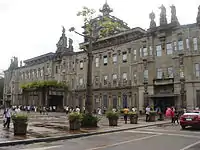University of Santo Tomas
The Pontifical and Royal University of Santo Tomas, the Catholic University of the Philippines, or simply the University of Santo Tomas (UST), is a private, Catholic research university in Manila, Philippines. Founded on April 28, 1611, by Spanish friar Miguel de Benavides, Archbishop of Manila, it has the oldest extant university charter in the Philippines and in Asia,[3][4] and is one of the world's largest Catholic universities in terms of enrollment found on one campus.[5][6] The university is run by the Order of Preachers. UST is the only university to have been visited by three popes four times: once by Pope Paul VI on November 28, 1970, twice by Pope John Paul II on February 18, 1981, and January 13, 1995, and once by Pope Francis on January 18, 2015.[7] The patron of the university is St. Thomas Aquinas, while St. Catherine of Alexandria is the patroness.[8]
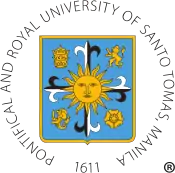 | |
| Latin: Pontificia et Regais Sancti Thomæ Aquinatis Universitas Manilana | |
Former names | See list |
|---|---|
| Motto | Veritas in Caritate |
Motto in English | Truth in Charity |
| Type | Private coeducational non-profit research university |
| Established | April 28, 1611 |
| Founder | Fr. Miguel de Benavides, O.P. |
Religious affiliation | Roman Catholic (Dominican) |
Academic affiliations | ICUSTA, AUN, ASAIHL, ASEACCU, COCTI, IAU, KAAD, PAASCU, IFCU |
| Chancellor | Very Rev. Fr. Gerard Francisco P. Timoner, III, O.P., SThL |
| Vice-Chancellor | Very Rev. Fr. Napoleon B. Sipalay, Jr., O.P. |
| Rector | Very Rev. Fr. Richard Ang, O.P. |
| Secretary General | Rev. Fr. Jesus M. Miranda, Jr., OP |
Academic staff | 1,500+ |
| Students | 44,791 (as of 2015)[1] |
| Undergraduates | 31,179 |
| Location | , Philippines 14°36′35″N 120°59′23″E |
| Campus | Urban, 21.5 ha (53 acres) |
| Patron saints | Patron Thomas Aquinas Patroness Catherine of Alexandria |
| Colors | Gold, Black, and White[2] |
| Nickname | Growling Tigers |
Sporting affiliations | UAAP |
| Sports | See list |
| Mascot | Bengal Tiger |
| Website | ust.edu.ph |
The university is composed of several autonomous faculties, colleges, schools and institutes, each conferring undergraduate, graduate and postgraduate degrees, and the basic education units. Several degree programs have been accredited by the Commission on Higher Education (CHED) as Centers of Excellence and Centers of Development. Moreover, it was awarded with an Institutional Accreditation by the CHED through the Federation of Accrediting Agencies of the Philippines. In December 2013, the university was recognized to have the highest number of accredited programs in the country by the Philippine Association of Colleges and Universities' Commission on Accreditation (PACUCOA).[9]
Prominent Thomasians include saints, Filipino presidents, heroes, artists, scientists, professionals, and religious figures, who have figured prominently in the history of the Philippines. The athletic teams are the Growling Tigers, who are members of the University Athletic Association of the Philippines and are consistent winners of the Overall Championship. The university campus is listed as one of the most viable sites in the Philippines to be included in the UNESCO World Heritage List, while the Archives of the University of Santo Tomas is listed as one of the most viable documentary heritage to be included in the UNESCO Memory of the World Programme.
History

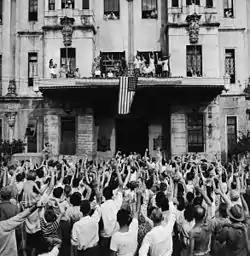
The foundation of the university is ascribed to Miguel de Benavides, O.P., the third archbishop of Manila. He came to the Philippines with the first Dominican mission in 1587. He went on to become bishop of Nueva Segovia, and was promoted archbishop of Manila in 1601. Upon his death in July 1605, Benavides bequeathed his library and personal property worth 1,500 pesos to be used as the seed fund for the establishment of an institution of higher learning. Fr. Bernardo de Santa Catalina carried out Benavides's wishes and was able to secure a building near the Dominican church and convent in Intramuros for the college.
In 1609, permission to open the college was requested from King Philip III of Spain, which only reached Manila in 1611. On April 28, 1611, notary Juan Illian witnessed the signing of the act of foundation by Baltasar Fort, OP, Bernardo Navarro, OP, and Francisco Minayo, OP. Fort, appointed that year to the post of Father Provincial, became the rector in 1619.[10]
The Colegio de Nuestra Señora del Santísimo Rosario, was established on April 28, 1611, from the Benavides's library. Later renamed Colegio de Santo Tomas, it was elevated by Pope Innocent X to a university on November 20, 1645, in his brief, In Supreminenti.[11] This makes the institution the first in the islands to be formally elevated to the status of university.
The authorities took the example of universities in Spain (such as the Universidad de Salamanca) and in Latin America (such as the Real y Pontifical Universidad de Mexico) to become a model for the university.
Its complete name is The Pontifical and Royal University of Santo Tomas, The Catholic University of the Philippines (Spanish: La Real y Pontificia Universidad de Santo Tomás de Aquino, La Universidad Católica de Filipinas).[12] It was given the title "Royal," by King Charles III of Spain in 1785; "Pontifical" by Pope Leo XIII in 1902 in his constitution, Quae Mari Sinico, and the appellative "The Catholic University of the Philippines" by Pope Pius XII in 1947.[13] This makes the UST the first and only formally declared royal and pontifical university in the Philippines.
The university was located within the walled city of Intramuros in Manila. It was started by the Spanish Archbishop of Manila in the early 17th century as a seminary for aspiring young priests, taking its name and inspiration from Saint Thomas Aquinas, a Dominican theologian. The first courses offered by the Colegio de Santo Tomas were canon law, theology, philosophy, logic, grammar, the arts, and civil law. In 1871, it began offering degrees in Medicine and Pharmacy, the first in colonized Asia.[4]
At the beginning of the 20th century, with the growing student population, the Dominicans were given a 21.5-hectare plot of land at the Sulucan Hills in Sampaloc, Manila and built its 215,000 square meter campus there in 1927 with the inauguration of its Main Building. Also that year, it began accepting female enrollees. In the last four decades, the university grew into a full-fledged institution of higher learning, conferring degrees in law, medicine, and various academic letters. The university has graduated Philippine national heroes, presidents, and even saints.[4] The Medicine and Civil Law courses were retained in Intramuros at that time.
During World War II, the Japanese forces converted the Sampaloc campus into an internment camp for enemy aliens, mostly Americans, living in the Philippines. The original Intramuros campus was destroyed in 1944 by a fire started by the Japanese Kenpeitai. More than 4,000 foreigners survived under difficult conditions in the internment camp for 37 months from January 1942 until February 1945 when the camp was liberated by American soldiers.[14]
Since its establishment in 1611, the University's academic life was interrupted only twice: from 1898 to 1899, during the Philippine Revolution against Spain, and from 1942 to 1945, during the Japanese occupation of the country. In its long history, the university has been under the leadership of more than 90 Rectors. UST's first Filipino rector was Fr. Leonardo Legaspi, O.P. who served UST from 1971 to 1977.
In recognition of its achievements, a number of important dignitaries have officially visited the university, among them, during the last four decades: Pope Paul VI on November 28, 1970; King Juan Carlos I of Spain in 1974 and 1995; Mother Teresa of Calcutta in January 1977 and again in November 1984; Pope John Paul II on February 18, 1981, and January 13, 1995 (as part of the World Youth Day 1995); Queen Sofia of Spain on July 6, 2012.[4] In January 1997, Chiara Lubich, foundress of the Focolare Movement also visited the University and was awarded an 'Honoris Causa' Degree in Sacred Theology. On January 18, 2015, Pope Francis also visited the university for the meeting with the students.
On the 2015–2016 academic year, UST had 44,791 students enrolled, up by 2.2 percent from last year's 43,818 [1]
Campus
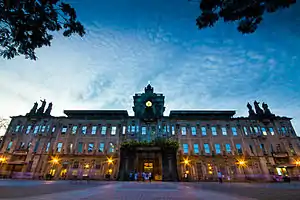
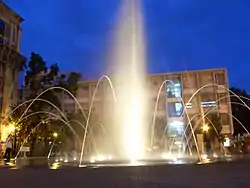
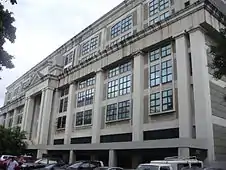
The University sits on an almost perfect square of 21.5 hectares bounded by España Boulevard, P. Noval St., A.H. Lacson Ave. and Dapitan St. in Sampaloc, Manila. The University transferred to its present campus in 1927 when the Dominicans deemed the Intramuros campus inadequate for the University's growing population. The first structures in the campus were the imposing Main Building, the Santisimo Rosario Parish church, the UST Gym (once the largest gym in the country), and the Arch of the Centuries.
The campus at present boasts a mixture of old and new architecture with the inclusion of the UST multi-deck carpark which houses the Alfredo M. Velayo College of Accountancy, and the UST Sports Complex, the second modern sports facility to be constructed by a UAAP member school.
The Central Seminary was built in the 1930s and was designed by Fernando Ocampo. The plan of the seminary was configured in the form of the letter E, with courtyards bisecting the wings. The boxy building had an elongated frontage assembling a continuous band of balconies and windows on the second and third level. The structure's horizontally oriented massing was broken by an engaged central section at the main entrance and two other similar treatments at the end portions. An art deco relief, bud-like finials, and a tableau embellished the stepped pylon at the entrance.[15]
The Engineering and Architecture Building, now called Roque Ruaño Building was built in 1952, designed by Julio Victor Rocha, initiated the application of the Niemeyer-inspired brise soleil in local buildings. The façade of the three-storey building displayed a continuous sun breaker that protected its second and third-storey windows. The trend for brise soleil followed the character of the building, which created many variations.[16]
Other new structures include the Beato Angelico Building which houses the College of Architecture and College of Fine Arts and Design, the Plaza Mayor, the UST Quadricentennial Square and Alumni Park, Thomas Aquinas Research Complex, Blessed Pier Giorgio Frassati Building, the UST Tan Yan Kee Student Centre, and the recently built, 12-floor Buenaventura Garcia Paredes, O.P. Building (UST Alumni Center) which houses students from the Faculty of Arts and Letters and the College of Tourism and Hospitality Management.
The streets of the university were non-existent until March 1960. The prominent university streets are Intramuros Drive, Quezon Drive, and Osmeña Drive.[17]
The UST Manila campus was declared a National Historical Landmark by the National Historical Commission of the Philippines on 24 May 2011. Four of the University's structures are also declared National Cultural Treasures by the National Museum: Main Building, Arch of the Centuries, Santissimo Rosario Central Seminary, as well as the Grandstand and the University field. UST is the first and only university campus to have been named a National Historical Landmark and the only learning institution in the Philippines as location of National Cultural Treasures.[18]
The Dominicans decided to integrate their schools in the Philippines. Integration started in 2017. The Angelicum College in Quezon City became UST Angelicum College and Aquinas University of Legazpi became UST-Legazpi (32 Hectares) through the memorandum of agreement signed by officials of involved schools. Also soon the Angelicum School of Iloilo will become UST Iloilo (25 Hectares).
The University has started to develop upcoming campuses in Santa Rosa City (45 Hectares) and General Santos City (82 Hectares).[19] In 2011, the University celebrated its 400th founding anniversary, and it is projected that the new campuses will be operational by then.[20]
Organization
| College/school founding | |
|---|---|
| College/school | Year founded |
| Sacred Theology | 1611 |
| Philosophy | 1611 |
| Canon Law | 1733 |
| Civil Law | 1734 |
| Medicine & Surgery | 1871 |
| Pharmacy | 1871 |
| Arts & Letters | 1896 |
| Engineering | 1907 |
| Education | 1926 |
| Science | 1926 |
| Architecture | 1930 |
| Commerce & Business Administration | 1934 |
| Graduate School | 1938 |
| Music | 1945 |
| Nursing | 1946 |
| Rehabilitation Sciences | 1974 |
| Fine Arts & Design | 2000 |
| Physical Education & Athletics | 2000 |
| Accountancy | 2005 |
| Tourism & Hospitality Management | 2009 |
| Information & Computing Sciences | 2014 |
| Graduate School of Law | 2017 |
The university has 19 civil colleges, 3 ecclesiastical colleges, and 3 secondary schools, which offer 105 undergraduate specializations and 75 graduate specializations. The degree programs for undergraduate studies were first offered in 1611 and post-graduate programs have been offered in the 17th century. A college is called a Faculty, a College, or an Institute depending on its foundation. The "Faculties" were founded before the American occupation of the early 20th century, while the "Colleges" were founded during and after American rule. The "Institutes" and "Departments" are found within their mother faculties/colleges. Some Institutes that attained enough enrollment were separated from their mother faculties/colleges and were made into colleges in their own right. UST evaluates at least 80,000 applicants every year and around 10,000 are admitted to the University.
The Faculty of Civil Law is one of the top performing schools in the history of the Philippine bar examinations.[21] It has produced four Philippine Presidents, three Philippine Vice Presidents, six Supreme Court Chief Justices, and several law deans in the country.[22] The Faculty of Medicine and Surgery is a Center of Excellence.[23] The Graduate School academic programs spans about seven clusters of disciplines. The UST Graduate School is recognized as a Center of Excellence in several fields of the Arts and Humanities, Allied Health Sciences, Natural Sciences, and Engineering by the Commission on Higher Education.[24]
UST has three secondary institutions: The UST Junior High School, the UST Education High School which serves as a laboratory for the College of Education,[25][26] and the UST Senior High School.
The UST Elementary School used to offer primary education for children in the K-12 levels,[27] but stopped accepting applications for the K-Level sometime before the Quadricentennial Celebration of the University. The UST Elementary School, after graduating the last batch of its students in the UST Sampaloc Campus, will be transferred to the new UST Campus in Santa Rosa City, Laguna.
Academic profile
Research
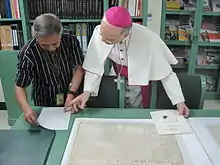
- Center for Creative Writing and Literary Studies (CCWLS) – unit that specialises in the development of national literature through programs, projects and activities. It was established in 1999 as the UST Center for Creative Writing and Literary Studies.[28]
- Center for Health Research and Movement Science (CHRMS) – research unit of the College for Rehabilitation Science. The center focuses on the assessment and interventions to improve health, fitness, and quality of life for different patient and client populations. It was inaugurated in 2003 as the Center for Research on Movement Science.[29]
- Center for Religious Studies and Ethics (CRSE) – research unit that focuses on issues that have religious and moral implications, as well as on teachings of Church Magisterium. It was established in 2013. The center was preceded by the Center for Contextualized Theology and Ethics established in July 2002. In 2006, it was restructure to become the John Paul II Center for Ecclesiastical Studies and UST Center for Ethics. Both centers were dissolved in 2009.[30]
- Research Center on Culture, Education, and Social Issues – research arm of the university that holds the activities the previous research centres namely: the Center for Educational Research and Development (CERD), the Social Research Center (SRC), and the Center for Intercultural Studies (CIS). CERD was established in June 1979 by Rev. Fr. Paul P. Zwanepoel. SRC was established in 1979. CIS was established as the Chiang Ching-kuo Centre for Intercultural Studies in 1993. RCCESI will soon be transitioning into two centers, the Research Center on Culture, Arts, and the Humanities (RCCAH), and the Research Center on Social Sciences and Education (RCSSED).[31]
- Research Center for the Natural and Applied Sciences (RCNAS) – research arm of the university that focuses on science and technology. Established in 1962, it was originally conceived as the University Research Center, encompassing both the cultural and the experimental sciences. However, in the succeeding years, it gradually assumed an orientation towards the natural sciences. The center also supervises the following offices:[32]
- UST Analytical Services Laboratory (ASL)
- UST Collection of Microbial Strains (UST-CMS)
- UST Herbarium
- UST Institutional Animal Care & Use Committee (UST-IACUC)
- Research Center for the Health Sciences – provides venue for research of faculty members from the Faculty of Medicine and Surgery, College of Nursing and College of Rehabilitation Science.[33]
- Center for Conservation of Cultural Property and Environment in the Tropics – research center of the UST Graduate School that specialises in consultancy, research, training and project development in heritage conservation and sustainable development. It was established in 2003.[34]
- Archives of the University of Santo Tomas (AUST)
- Educational Technology Center
- Miguel de Benavides Cancer Institute – center that offers a multi-disciplinary professional medical service for patients needing cancer care.[35]
Publications
The UST Publishing House (USTPH) was established in 1996 through the merger of the Santo Tomas University Press (STUP) and the UST Printing Office (USTPO). The Publishing House evolved from the UST Press, which was founded in 1593 by Fr. Francisco de San Jose, O.P. As such, it is one of the oldest continuing press in the world today, only next to Cambridge University in England.[36]
Academic and research journals
- Acta Manilana, a journal for the natural and applied sciences
- The Antoninus Journal (formerly Ad Veritatem), a multi-disciplinary research journal of the UST Graduate School
- The Asian Journal of English Language Studies, the journal of the UST Department of English
- Boletin Ecclesiastico, the Official Interdiocesian Journal of UST
- De Las Casas, the UST Community Development journal
- Hasaan, the journal of the UST Department of Filipino
- Kritike, the journal of the UST Department of Philosophy
- Philippiniana Sacra, a publication of the Ecclesiastical Faculties
- Santo Tomas Journal of Medicine, a publication of the Faculty of Medicine and Surgery
- Tomas, literary journal of the Center for Creative Writing and Studies
- UST Law Review, a journal of the Faculty of Civil Law
- Philippine Journal of Allied Health Sciences, a research journal of the UST Center for Research on Movement Science
- Unitas, a semi-annual peer reviewed journal of advanced research in literature, culture and society
- UST College of Science Journal - a research journal of the UST College of Science
Newsletters
- Academia, the official international bulletin of the University of Santo Tomas
- Thomasian Sunscope, the official alumni newsletter of the University of Santo Tomas
- The Varsitarian, the official university weekly student newspaper
- La Stampa, the official university Senior High School student newspaper
- The Aquinian, the official university Junior High School student newspaper
Rankings and reputation
| University rankings | |
|---|---|
| Global – Overall | |
| QS World[37] | 801-1000 (2021) |
| QS Employability[38] | 251-300 (2020) |
| Regional – Overall | |
| QS Asia[39] | 186 (2021) |
| National – Overall | |
| QS National[40] | 4 (2021) |
The university is regarded by the Philippines' Commission on Higher Education (CHED) as one of the top universities in the Philippines together with University of the Philippines (system), Ateneo de Manila University and De La Salle University.[41] Internationally, it is the first and only university in the country to be recognized by the Quacquarelli Symonds (QS) University Rankings with four stars for excellence (five as the highest) as an institution and five stars in the areas of employability, facilities, social responsibility and inclusiveness.[42] It has been ranked in the QS Asian University Rankings 2021 (186),[42] QS World University Rankings 2021 (801-1000), QS Graduate Employability Rankings 2020 (251-300) and THE Impact Rankings 2020 (301-400)[43]
CHED has awarded 12 Centers of Excellence and 11 Centers of Development designations to UST.[44] According to CHED, the designation Center of Excellence "refers to a department within a higher education institution, which continuously demonstrates excellent performance in the areas of instruction, research and publication, extension and linkages and institutional qualifications." The designation Center of Development, on the other hand, "refers to a department within a higher education institution, which demonstrates the potential to become a Center of Excellence (COE) in the future."[45]
| Designation | Subject Area |
|---|---|
| Center of Excellence | Hotel and Restaurant Management |
| Center of Excellence | Tourism |
| Center of Excellence | Chemical Engineering |
| Center of Development | Civil Engineering |
| Center of Development | Electrical Engineering |
| Center of Development | Electronics Engineering |
| Center of Development | Industrial Engineering |
| Center of Development | Mechanical Engineering |
| Center of Excellence | Medical Technology/Medical Laboratory Science |
| Center of Excellence | Medicine |
| Center of Excellence | Nursing |
| Center of Excellence | Pharmacy |
| Center of Development | Physical Therapy |
| Center of Development | Literature |
| Center of Excellence | Philosophy |
| Center of Development | Information Technology |
| Center of Development | Library and Information Science |
| Center of Excellence | Biology |
| Center of Excellence | Chemistry |
| Center of Development | Communication |
| Center of Development | Journalism |
| Center of Excellence | Psychology |
| Center of Excellence | Teacher Education |
Student life


Events and traditions
- Misa de Apertura (The Opening Mass for the Academic Year)
- The Thomasian Welcome Walk – (formerly The Rites of Passage) Freshmen pass under the Arch of the Centuries at the start of their education at the university. It was established in 2003.[47]
- The USTv Students' Choice Awards on Television – Established in 2005, is an award-giving body by Thomasians for Philippine Television that upholds Christian moral and ideals.
- UST Paskuhan – Primered by the Eucharistic Celebration, the Paskuhan is the Thomasian way of celebrating Christmas, with performances from different student organizations, live bands, and other shows. It also featured a Holy Mass and an inter-collegiate lantern-making contest.[48]
- UST Baccalaureate Mass, Ceremony of the Light, and The Sending off Rites
- UST annual Goodwill Tournaments for various sports for all colleges. (Football, basketball, swimming, volleyball, etc.)
Sports

UST is a founding member of the University Athletic Association of the Philippines (UAAP) and of the National Collegiate Athletic Association.[49] The varsity sports teams, originally called the "Glowing Goldies", have since been renamed the Growling Tigers beginning the 1992–1993 UAAP season. UST has won the men's basketball title 18 times since 1938. The University also participates in all the UAAP events.
The women's teams are called the Tigresses, while the juniors' (high school) teams are the Tiger Cubs.
The University continues to dominate the UAAP with most number of general championship titles. UST has won seniors' crown 44 times, holding it 33 times in the last 38 years including the record high 14-year dynasty run. The juniors' team yields 21 titles out of 26 seasons.
The official dance troupe, the Salinggawi Dance Troupe with the official pep squad, UST Yellow Jackets, has won the UAAP Cheerdance Competition for five consecutive seasons.[50]
In the 69th season of UAAP in academic year 2006–2007, the men's team captured the basketball crown defeating the Ateneo Blue Eagles in two of the three games held.[51] In women's basketball, the Tigresses defeated the FEU Lady Tamaraws for the title.[52] With the championship, the UST Growling Tigers ties the UE Red Warriors with 18 UAAP men's basketball titles, behind the league-leading FEU Tamaraws with 20. UST also won a senior NCAA championship, to bring the total to 19 men's championships.
Media
UST has multiple student organizations that cater to different media. The Varsitarian, commonly referred to as Varsi, is the official student publication of the university; Tomasian Cable Television (TOMCATv) was the official broadcasting arm of the university, in 2017 TOMCATv re-branded into "TOMCAT" as "Tomasian Media Circle and Talents" an events and video production organization, while the official broadcasting arm renamed into TigerTV (YouTube.com/TomasinoEdTech) and TigerRadio (mixlr.com/tigeradio) which operates under the digital broadcasting unit of the Educational Technology Center or "EdTech," TOMCATv; TomasinoWeb or TomWeb is the university's official digital media organization and online student publication. In February 2019, The Varsitarian published an editorial which critically condemned attacks on press freedom, a day after a Filipino journalist was arrested by the Duterte government. The university administration tried to squash the publication, only to be repulsed by students in protest condemning all forms of attacks against freedom and liberty.[53]
UST Tiger Radio
In the late 2000s, UST through its Tomasian Cable Television (divided into two organizations: the Tiger Media Network and TOMCAT) launched UST Tiger Radio. UST Tiger Radio currently broadcasts online via web streaming from Monday to Friday, except during semester breaks. It is also the current official campus station of the UST community.
Stand on LGBT rights
The University of Santo Tomas administration, led by Catholic priests, has historically been against LGBT. In the 1960s, the first LGBT organization, Tigresa Royal, in the university was established. However, the organization dissipated during the martial law era. The organization was never recognized by the university. In 2013, HUE, a new LGBT organization in the university was formally established. The organization was established by Majann Lazo, student council president of the Faculty of Arts and Letters, and Noelle Capili, a member of Mediatrix, a university-wide organization for art enthusiasts. Like Tigresa Royal, the university also denies HUE's recognition as a university organization.[54]
On July 1, 2015, the university ordered numerous organizations to 'take down' all rainbow-themed profile pics of its members in social media after the legalization of same-sex marriage in the United States. The order was defied by numerous students of the university, marking the beginning of the UST Rainbow Protest. In July 2016, various student organizations supported the filing of the SOGIE Equality bill in the Senate and the House of Representatives.[55][56]
In March 2018, during the passage of the SOGIE Equality Bill in the Philippine House of Representatives, numerous UST student organizations, including the first intersectional feminist organization in the school, UST Hiraya, backed the bill's passage.[57]
On June 21, 2018, statements against the UST LGBT community were circulated in Twitter and Facebook. The statements originally came from the school regent, Fr. Boy. The tweet noted that the school 'understands' LGBT rights, but tasked all presidents of all student organizations within the university to take down pro-LGBT statements, especially if those statements involved the words, 'LGBT' and 'Pride month'. The statements garnered massive backlash against the university in social media, with almost 4,000 disapprovals and around 1,100 retweets in less than two days. The order of the school regent was also defied by numerous UST organizations, in continuation of the UST Rainbow Protest.[58][59] In July 2018, the university and its Catholic priests banned all forms of cross-dressing within its campus. The university also deemed that students who have same-sex relationships shall face “non-readmission, exclusion or expulsion”.[60]
On August 7, 2018, in defiance against the school administration, the university's Catholic student council launched a collective statement with fellow Catholic student councils from Ateneo de Manila University, De La Salle University, De La Salle–College of Saint Benilde, Miriam College, St. Scholastica's College, Manila and San Beda University, calling on the Senate of the Philippines to enact the pro-LGBT SOGIE Equality Bill into law. The move marked the first ever inter-school Catholic-based LGBT support system in Philippine history.[61]
Notable people
Alumni
 National Hero of the Philippines Jose Rizal (Medicine)
National Hero of the Philippines Jose Rizal (Medicine)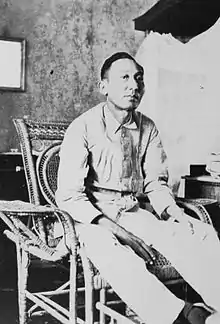 1st Prime Minister of the 1st Philippine Republic Apolinario Mabini (LL.B. 1894)
1st Prime Minister of the 1st Philippine Republic Apolinario Mabini (LL.B. 1894)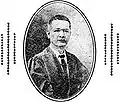 1st Chief Justice of the Supreme Court of the Philippines under the American Civil Government Cayetano Arellano (B.Phil. 1862; B.Th. 1867; J.C.B., B.C.L. 1871; LL.B. 1876)
1st Chief Justice of the Supreme Court of the Philippines under the American Civil Government Cayetano Arellano (B.Phil. 1862; B.Th. 1867; J.C.B., B.C.L. 1871; LL.B. 1876)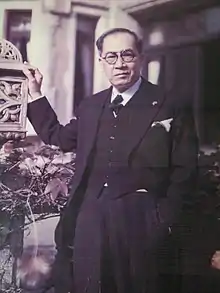 3rd President of the Philippines, President of the 2nd Republic Jose P. Laurel (A.B., PhD 1919)
3rd President of the Philippines, President of the 2nd Republic Jose P. Laurel (A.B., PhD 1919)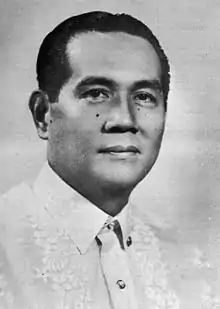 9th President of the Philippines Diosdado Macapagal (LL.B. 1936)
9th President of the Philippines Diosdado Macapagal (LL.B. 1936) 4th President of the Philippines Sergio Osmeña (LL.B. 1903)
4th President of the Philippines Sergio Osmeña (LL.B. 1903).jpg.webp) 2nd President of the Philippines Manuel L. Quezon (LL.B. 1903)
2nd President of the Philippines Manuel L. Quezon (LL.B. 1903)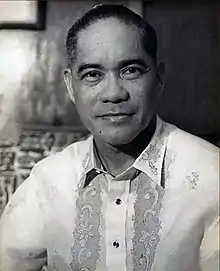 12th President of the Senate of the Philippines Arturo Tolentino (D.C.L.)
12th President of the Senate of the Philippines Arturo Tolentino (D.C.L.)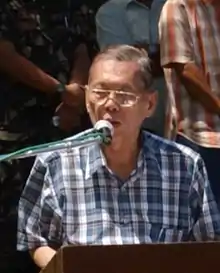 Former Secretary of Justice (Philippines) Raul M. Gonzalez (LL.B. 1955)
Former Secretary of Justice (Philippines) Raul M. Gonzalez (LL.B. 1955)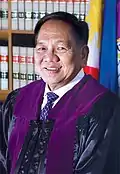 162nd Associate Justice of the Supreme Court of the Philippines, Former Sandiganbayan Presiding Justice Diosdado Peralta (LL.B. 1979)
162nd Associate Justice of the Supreme Court of the Philippines, Former Sandiganbayan Presiding Justice Diosdado Peralta (LL.B. 1979)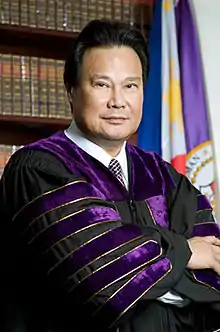 23rd Chief Justice of the Supreme Court of the Philippines Renato Corona (D.C.L.)
23rd Chief Justice of the Supreme Court of the Philippines Renato Corona (D.C.L.) Senator of the Philippines Joel Villanueva (B.S. 1996)
Senator of the Philippines Joel Villanueva (B.S. 1996).jpg.webp) Founder and Chairman of Jollibee Foods Corporation, Tony Tan-Caktiong (B.S. 1975)
Founder and Chairman of Jollibee Foods Corporation, Tony Tan-Caktiong (B.S. 1975)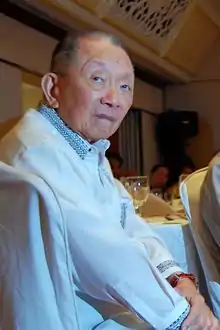 Founder of SyCip Gorres Velayo & Co. (SGV & Company) Washington SyCip (B.S.)
Founder of SyCip Gorres Velayo & Co. (SGV & Company) Washington SyCip (B.S.)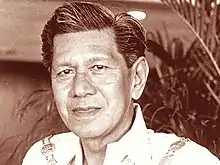 National Artist of the Philippines for Literature Nick Joaquin (A.A.)
National Artist of the Philippines for Literature Nick Joaquin (A.A.)
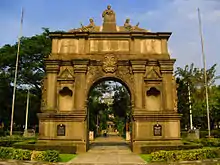
Persons affiliated to the university, either as students, faculty members, or administrators, are known as "Thomasians". José Rizal (National Hero of the Philippines), studied Medicine at UST, and continued it at the University of Madrid in Madrid, Spain. The University has produced four Presidents of the Philippines, namely Manuel L. Quezon,[62] Sergio Osmeña,[63] José P. Laurel and Diosdado Macapagal. It has also produced three Philippine Vice Presidents and six Chief Justices of the Philippine Supreme Court.
Philippine Commonwealth President Manuel L. Quezon and Philippine national hero José Rizal are honored by the University as they are displayed on the pillars of the Arch of the Centuries.
The UST Office for Alumni Relations build a twelve-story alumni center on the site of existing UST gymnasium; it is a multi-function building to hold events for the alumni and lodging services for visitors. The existing Olympic-sized swimming pool located nearby would be kept and refurbished.
The design was chosen from seven winners in a competition among students organized by the College of Architecture. Abelardo Tolentino Jr., an outstanding Thomasian alumni for Architecture, worked on the design to produce the final blueprint.[64]
References
- Santos, Tomas U. (October 29, 2015). "Freshman enrollment down ahead of K to 12". The Varsitarian. Retrieved March 28, 2015.
- University of Santo Tomas Visual Identity Manual (PDF). March 2019. Retrieved June 1, 2020.
- Lim-Pe, Josefina (1973). The University of Santo Tomas in the Twentieth Century. University of Santo Tomas Press, Manila. pp. 1–19.
- History of UST UST.edu.ph. Retrieved December 21, 2008.
- "University of Santo Tomas: 400 Years of Unending Grace". Ust.edu.ph. Retrieved December 16, 2010.
- Pontifical and Royal University of Santo Tomas Archived October 3, 2011, at the Wayback Machine. Retrieved from www.eskwelahan.net.
- Romero, J.I., University of Santo Tomas: 400 years of Unending Grace. Retrieved from www.ust.edu.ph.
- Lim-Pe, Josefina. 2000. The University of Santo Tomas in the Twentieth Century. University of Santo Tomas Press, Manila.
- Ramirez, C. and Terre, G. December 2013. Archived June 10, 2015, at the Wayback Machine UST has most number of accredited programs in the Philippines – PACUCOA. Retrieved from opphil.org.
- De Ramos, N.V., 2000. I Walked with Twelve UST Rectors.
- History of UST Archived 2007-05-09 at the Wayback Machine UST.edu.ph. Retrieved August 6, 2006.
- UST Museum of Arts and Sciences – University Rector's academic insignias
- History of UST Archived 2007-05-09 at the Wayback Machine UST.edu.ph. Retrieved October 30, 2008.
- Victims of Circumstance: Santo Tomas Internment Camp. Accessed September 11, 2011.
- Lico, Gerard (2008). Arkitekturang Filipino: A History of Architecture and Urbanism in the Philippines. Quezon City: The University of the Philippines Press. p. 339. ISBN 978-971-542-579-7.
- Lico, Gerard (2008). Arkitekturang Filipino: A History of Architecture and Urbanism in the Philippines. Quezon City: The University of the Philippines Press. p. 430. ISBN 978-971-542-579-7.
- Who cares about UST's streets?, retrieved 26 January 2011
- Madrid, R.D. (August 11, 2011). "UST, dineklarang 'national historical landmark'". The Varsitarian. Retrieved August 12, 2011.
- UST eyes Sri Lanka campus Archived 2007-03-11 at the Wayback Machine The Varsitarian. Published July 2004
- Fr. Lana's term (1998-2006) Archived 2006-08-18 at the Wayback Machine The Varsitarian website. Retrieved August 6, 2006.
- Statistical Data of Bar Examination Passing Rates, Office of the Bar Confidant, Supreme Court of the Philippines, 2000-2006.
- Faculty and alumni list, University of Santo Tomas Faculty of Civil Law, 2007.
- List of Centers of Excellence and Centers of Development, Commission on Higher Education (CHED), Republic of the Philippines, 2007.
- UST Graduate School website. Retrieved August 6, 2006.
- UST Junior High School website. Retrieved June 1, 2016.
- UST Education High School Archived 2013-05-22 at the Wayback Machine website. Retrieved June 1, 2006.
- "Archived copy". Archived from the original on November 13, 2011. Retrieved October 11, 2010.CS1 maint: archived copy as title (link)
- Center for Creative Writing and Literary Studies. UST.edu.ph Retrieved March 9, 2016.
- Center for Health Research and Movement Science. UST.edu.ph. Retrieved March 9, 2016.
- Center for Religious Studies and Ethics. UST.edu.ph. Retrieved March 9, 2016.
- Research Center on Culture, Education, and Social Issues. UST.edu.ph. Retrieved March 9, 2016.
- Research Center for the Natural and Applied Sciences. UST.edu.ph. Retrieved March 9, 2016.
- Research Center for the Health Sciences. UST.edu.ph. Retrieved March 9, 2016.
- Center for Conservation of Cultural Property and Environment in the Tropics. UST.edu.ph. Retrieved March 9, 2016.
- "About USTH". Usthospital.com.ph. August 21, 2006. Archived from the original on July 27, 2011. Retrieved December 16, 2010.
- UST Publishing House website. Retrieved February 22, 2008.
- "QS World University Rankings 2021". November 26, 2020. Retrieved November 26, 2020.
- "QS Graduate Employability Rankings 2020". Quacquarelli Symonds. Retrieved April 27, 2020.
- "QS Asia University Rankings 2021". November 26, 2020. Retrieved November 26, 2020.
- "QS Asia University Rankings 2021". November 26, 2020. Retrieved November 26, 2020.
- http://www.philstar.com/campus/2014/05/26/1327524/university-rankings-find-out-how-your-school-does Archived 2017-07-03 at the Wayback Machine top
- "University of Santo Tomas". Top Universities.
- "THE Impact Rankings 2020". Times Higher Education World University Rankings. Retrieved November 26, 2020.
- "List of Centers of Excellence and Development" (PDF). CHED - The Official Website of Commission on Higher Education. Retrieved May 2, 2020.
- "Centers of Excellence and Centers of Development (COES&CODS) - CHED". CHED - The Official Website of Commission on Higher Education. Retrieved May 2, 2020.
- "List of Centers of Excellence and Development". CHED - The Official Website of Commission on Higher Education. Retrieved May 2, 2020.
- Thomasian Welcome Walk 2008. Retrieved July 4, 2008.
- Christmas in our hearts Archived 2008-12-05 at the Wayback Machine The Varsitarian Vol. LXXIV, No. 8 • December 15, 2004
- The UAAP A Historical Account Archived 2009-07-03 at the Wayback Machine UAAPGames.com. Retrieved August 6, 2006.
- UST Claims 4th Straight Cheer Crown Archived 2007-03-11 at the Wayback Machine UBelt.com. Retrieved August 6, 2006.
- UST Tigers grab 19th UAAP title in overtime INQ7.net. Retrieved October 3, 2006.
- Tigers maul Eagles, forge rubber match; Deciding Game 3 set tomorrow INQ7.net. Retrieved October 1, 2006.
- href=, <a. "Assault on press freedom allows madmen free rein".
- "LGBT Org Strives for Recognition in UST • TomasinoWeb". tomasinoweb.org. Retrieved September 2, 2018.
- "Student org takes down 'gay pride' profile pics". varsitarian.net. Retrieved September 2, 2018.
- "UST online student paper ignites controversy over LGBT flag posting". Archived from the original on August 20, 2018. Retrieved September 2, 2018.
- "Debunking Some Misconceptions About the SOGIE Equality Bill". March 19, 2018. Retrieved September 2, 2018.
- "FJ on Twitter". Retrieved September 2, 2018.
- "UST Artlets Student Council (ABSC) on Twitter". Retrieved September 2, 2018.
- "Philippines university bans gay relationships and cross-dressing". July 18, 2018.
- "Catholic student councils to senators: End debate, pass SOGIE". Retrieved September 2, 2018.
- President Manuel L. Quezon 128th Birth Anniversary Manila Bulletin (Google archive). Published August 19, 2006
- Osmeña, Sergio World War II Database. Retrieved August 22, 2006.
- Four-story alumni center soon to rise. Retrieved 27 October 2010.
External links
| Wikimedia Commons has media related to University of Santo Tomas. |
- University of Santo Tomas – official website
- Santisimo Rosario Parish – Santisimo Rosario Parish
- Historical documentary synopsis of the University of Santo Tomas of Manila from its foundation to our day, Fr. Juan Sanchez y García, Santo Tomas University Press, Manila, 1929
- El tricentenario de la Universidad de Santo Tomás de Manila. Relacion de las fiestas, actos y certámenes celebrados en esta ciudad de Manila durante los dias 16, 17, 18, 19 y 30 de diciembre del aṅo 1911. Lo publica la junta organizadora del tricenternario. El tricentenario de la Universidad de Santo Tomas de Manila (1611-1911)] (English: The 300th anniversary of University of Santo Tomas), published in Manila, 1912
- Herbermann, Charles, ed. (1913). . Catholic Encyclopedia. New York: Robert Appleton Company.
